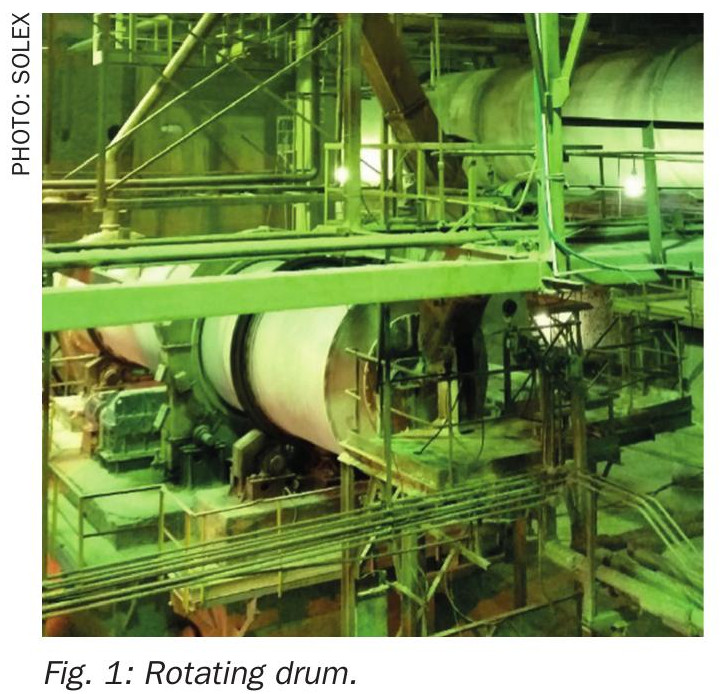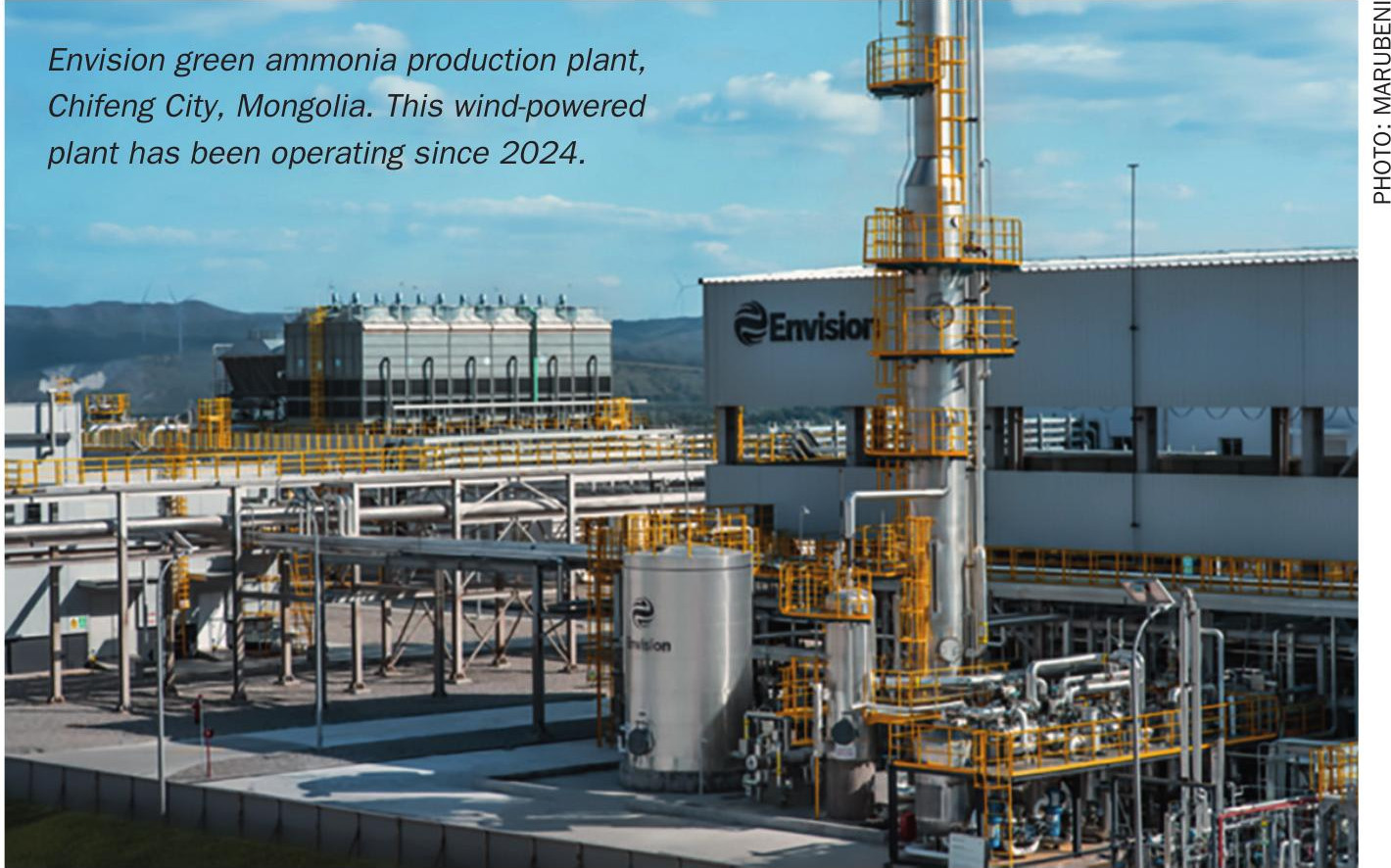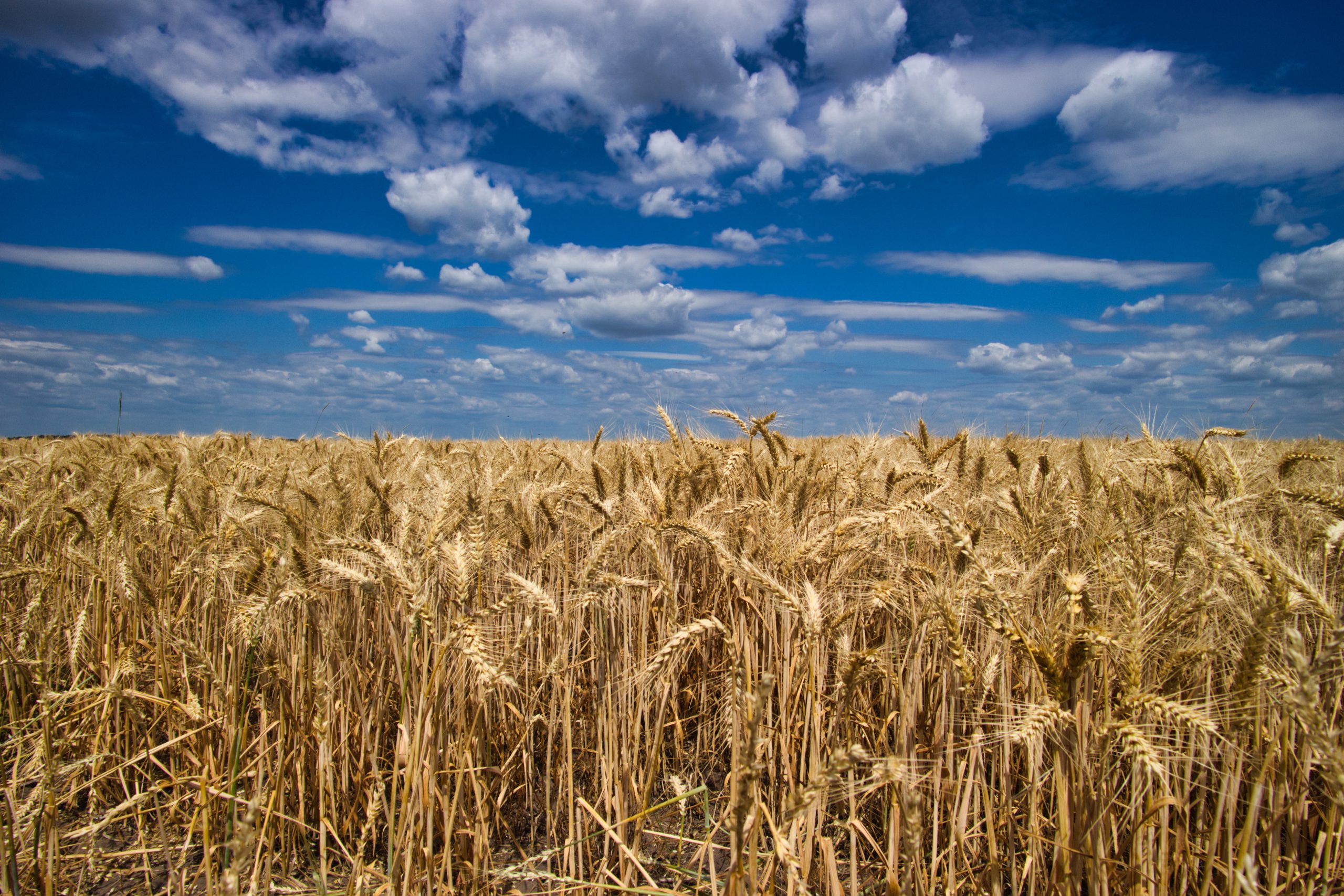Fertilizer International 527 Jul-Aug 2025
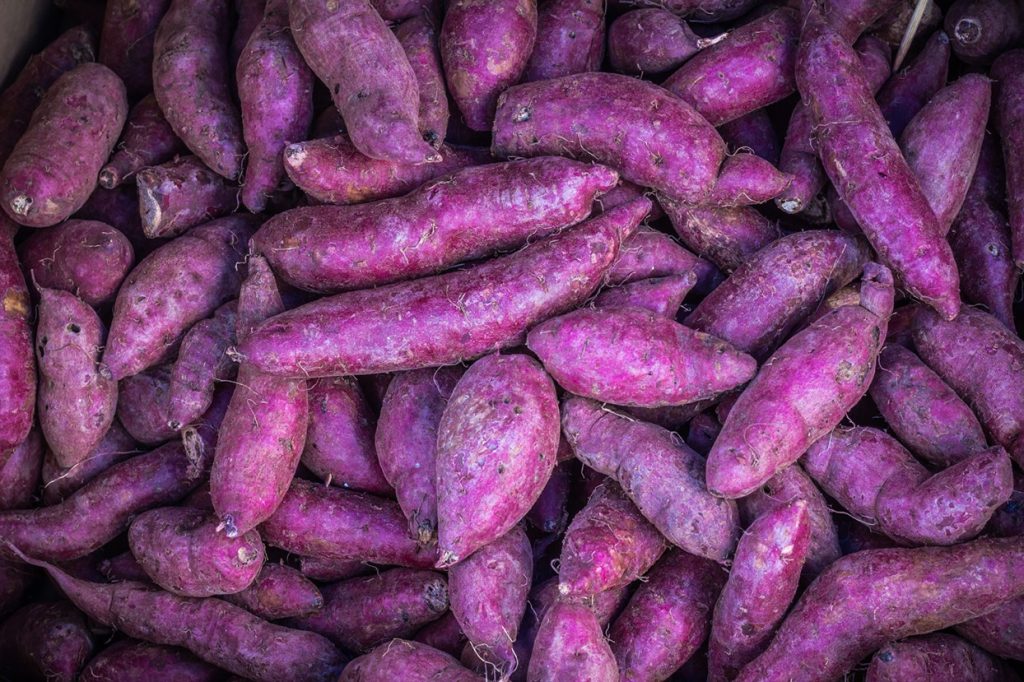
8 July 2025
High potassium uptake in specialty crops
POTASSIUM FERTILIZER OPTIONS
High potassium uptake in specialty crops
Dr Karl Wyant, Nutrien’s Director of Agronomy, showcases three popular specialty crops, oil palm, potatoes, and grapes, due to their strong potassium demands, relative global value, and potential for improved potassium nutrient management.
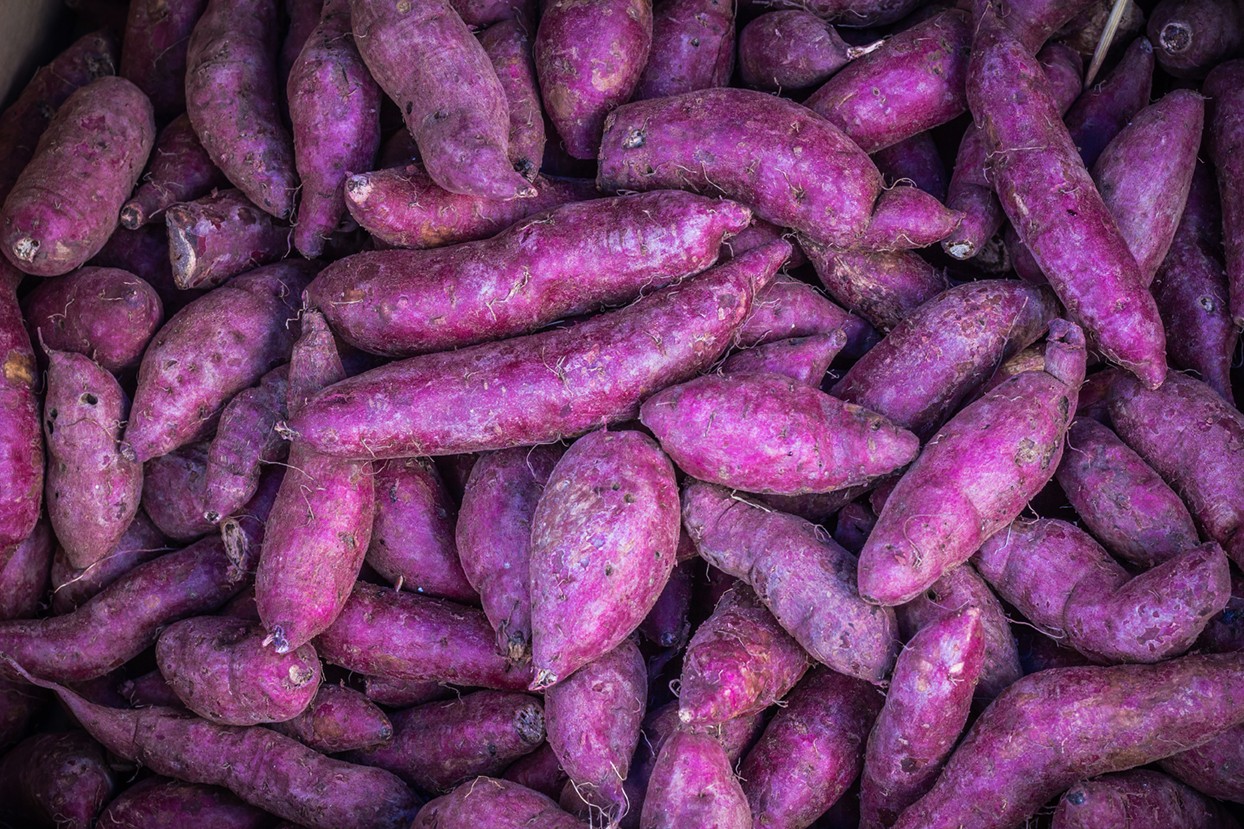
A vital nutrient with knowledge gaps
The potassium (K) nutrition of crops is vital (Figure 1) and has received more attention in recent years due to global reports of increased soil deficiency and associated yield losses.
Short-term potassium deficiencies occur when the supplying power of both the soil and fertilizer cannot keep up with the daily uptake by the crop during the active growing season. Long-term potassium deficiency in soils can also be created when potassium inputs to the system (e.g., K supply from fertilizers and manures) do not match potassium offtake from the field at harvest (e.g., K removal by potato tubers).
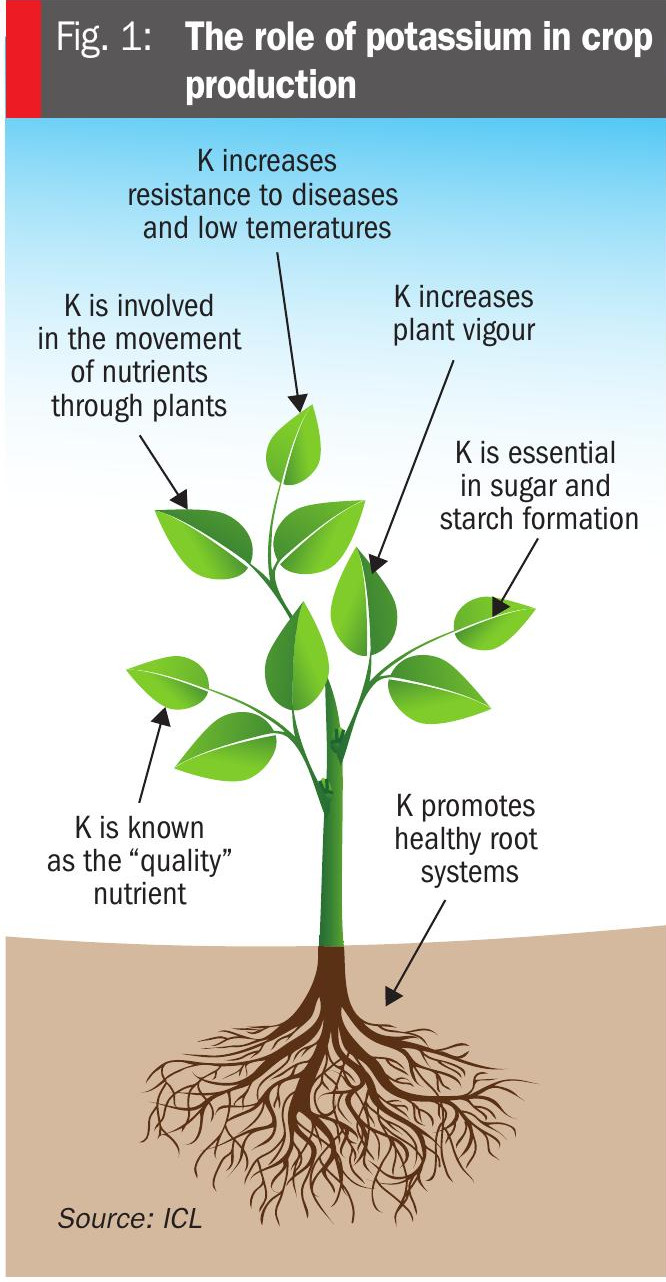
The resulting imbalance in the potassium ‘budget’ (i.e., where nutrient removals exceed nutrient inputs) can result in the gradual drawdown of the soil’s K reserves, leading to deficiency occurring with increasing frequency over time1 . In many areas of the globe, K inputs from fertilizer – such as muriate of potash (MOP 0-0-60 or 0-0-62) – and manures have not kept pace with increasing yields, leading to consistent patterns of recurring K deficiency.
Another complication to the potassium story is the relative lack of published agronomic trial data, compared to nitrogen and phosphate (N & P), the more popular of the ‘Big 3’ plant nutrients. In a recent presentation, Walter Carciochi of the University of Nebraska and fellow researchers estimated there was one potassium study for every seven nitrogen studies and 2.5 phosphate studies, based on the number of papers published in the final year of their literature analysis (Figure 2).
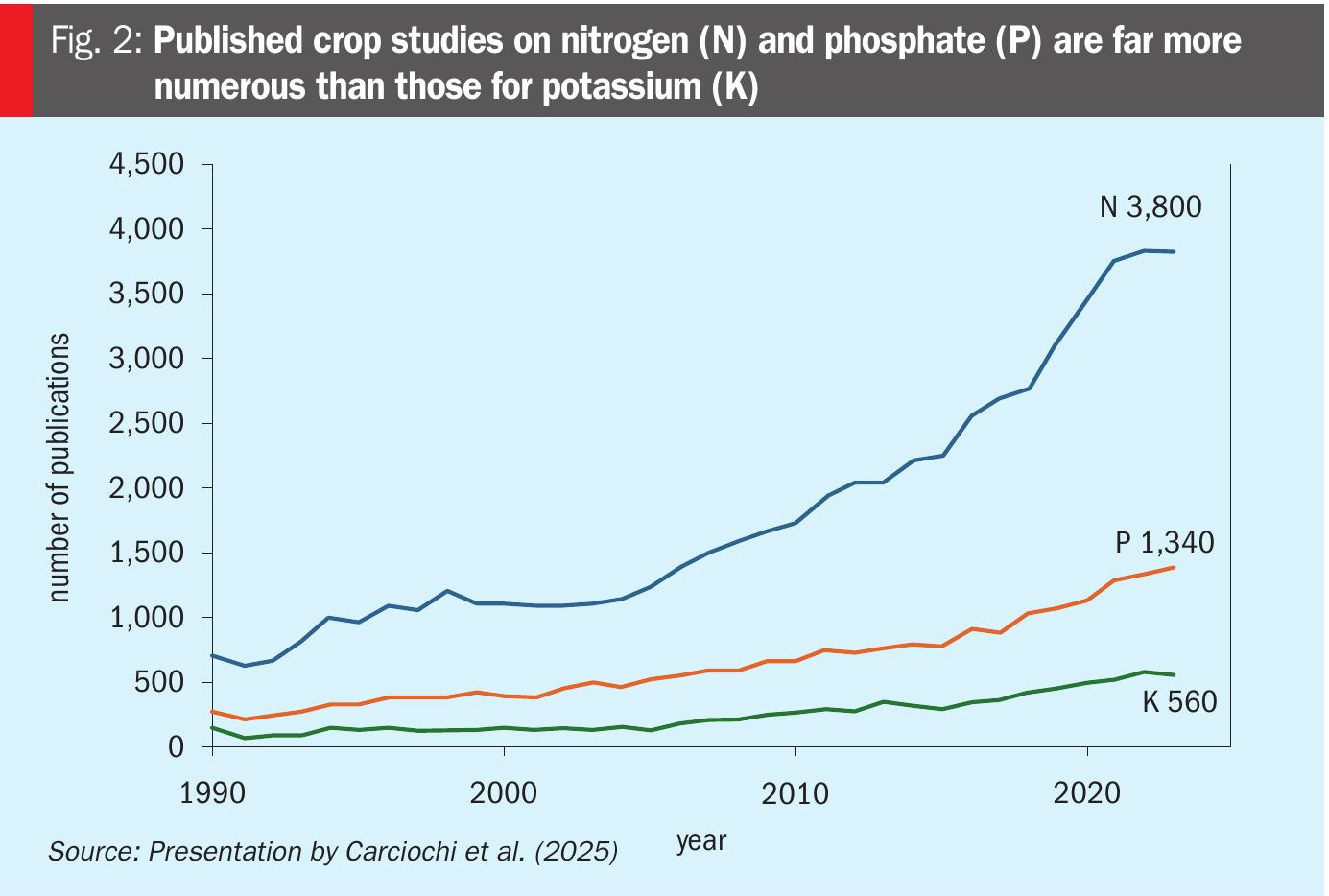
This relative absence of evidence is exacerbated by the fact that many published K studies concentrate solely on potassium uptake and its impact on yields for the ‘Big 4’ row crops, maize, soya, wheat, and rice. This leaves a crucial knowledge gap about the potassium fertilization of important specialty and horticulture crops, these being popular options for growers located in suitable climates.
In this article, I will highlight potassium use by three popular specialty crops – oil palm, potatoes and grapes – due to their global value, strong K demands, and the potential for improved management of this major nutrient.
Crop value and crop potassium demand
Oil Palm, potatoes, and grapes can be used to showcase potassium dynamics in this article because of the availability of crop uptake and removal data for potassium and published nutrient uptake graphs. Similar uptake estimates and charts exist for other specialty crops (citrus, sugar cane, almonds, etc.) and it is therefore likely that a local crop expert can readily produce these for growers should they be needed
Table 1 shows key 2016 global agricultural metrics for oil palm, potatoes, and grapes, in terms of the crop value and metric tonnages produced. Of relevance to this article are both total crop requirement for potassium and potassium removal by the crop at harvest (kg K2O/ha basis). These are shown for each tonne per hectare of crop yield (1 t/ha).

Farm-level potassium uptake and removal can be calculated simply by multiplying the numbers listed on the right side of the Table 1 by the farm yield (t/ha). In general, these data highlight the large quantities of potassium needed for growing crops of marketable quality at high yields.
Examples of K allocation in specialty crops are shown below.
Oil palm
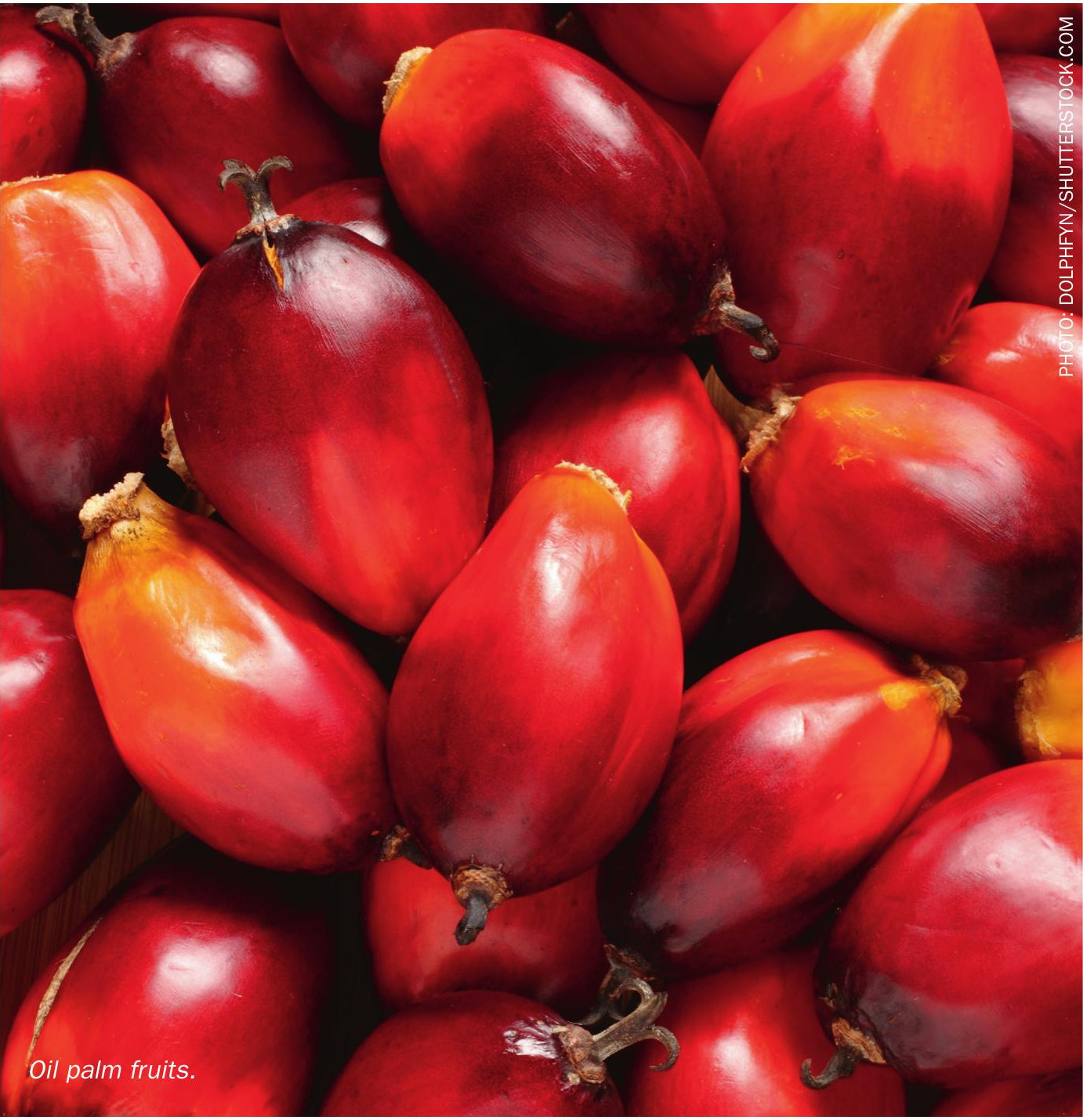
Oil palm fruit can be processed to generate an important vegetable oil – palm oil – at high yields, making it an important crop for hot, humid regions.
Palm oil and palm kernel oil held a 35 percent share of total global vegetable oil production in 2020/21, according to USDA, with 73.8 million tonnes of palm oil produced that year. Southeast Asia (mainly Indonesia and Malaysia) contributed 84 percent to this production total with the rest produced in Africa and Latin America.
The yield per hectare from oil palm plantations is considerably higher than for other oilseed crops (rapeseed, soybean, sunflower, etc.) and a developed field can produce for several years before being replanted. Consequently, oil palm remains an attractive and profitable crop choice in suitable growing regions.
Oil palm has a particularly high potassium demand – showing a staggering requirement of around 250 kg K2O/ha/yr (!) during peak production between years two and eight. Furthermore, there is a direct connection between potassium uptake and crop performance and oil yield (Figure 3).
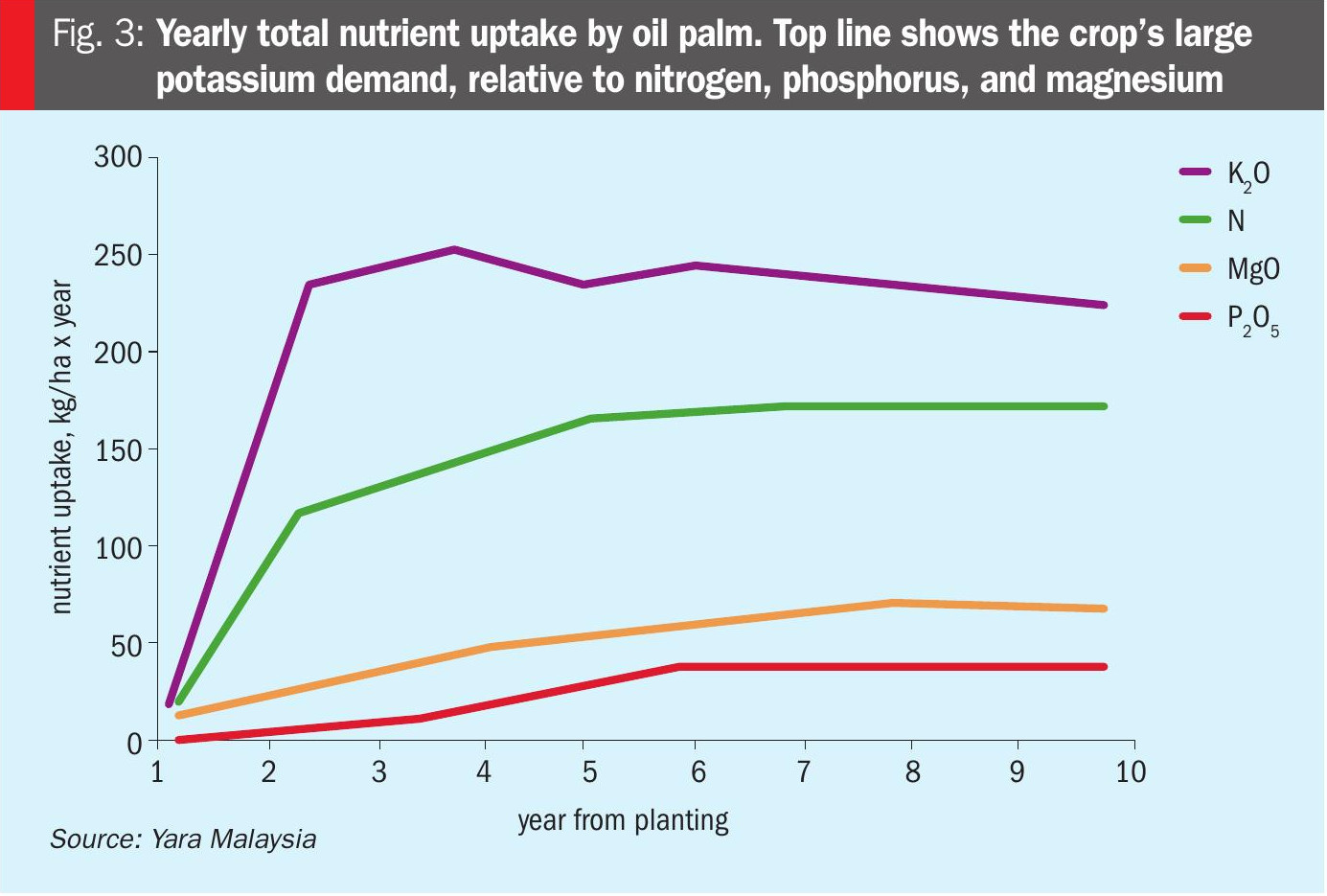
Due to the high potassium demand of oil palm, growers routinely apply potassium fertilizers to help support high yields over the lifetime of the crop. Indeed, potassium fertilizers are often the largest nutrient input for the grower and much attention is paid to proper K management. harvested fruit and the tolerance of grapevines to a wide variety of growing conditions.
Potatoes
Potatoes are a starchy crop and carbohydrate staple in many parts of the world. Prized for its versatility, harvested tubers can be peeled and cooked fresh or frozen, fried into chips (crisps), or even fermented to produce alcoholic drinks. Unsurprisingly, given the wide variety of ways potatoes are consumed, this crop is top of mind for growers and consumers alike across the globe.
What is less well known is the strong potassium demand required by high yielding, high quality potato crops during the growing season (Figure 4). At its peak, roughly 80 days after planting, the daily potassium demand (elemental K) of potato is more than double that of nitrogen. The peak in dry matter accumulation (the portion harvested for food production) also occurs shortly after N and K uptake reach their maximum.
Field observations and research have shown that potassium plays an outsized role in influencing potato crop yield and quality. Figure 4 helps illustrate exactly why this is the case.
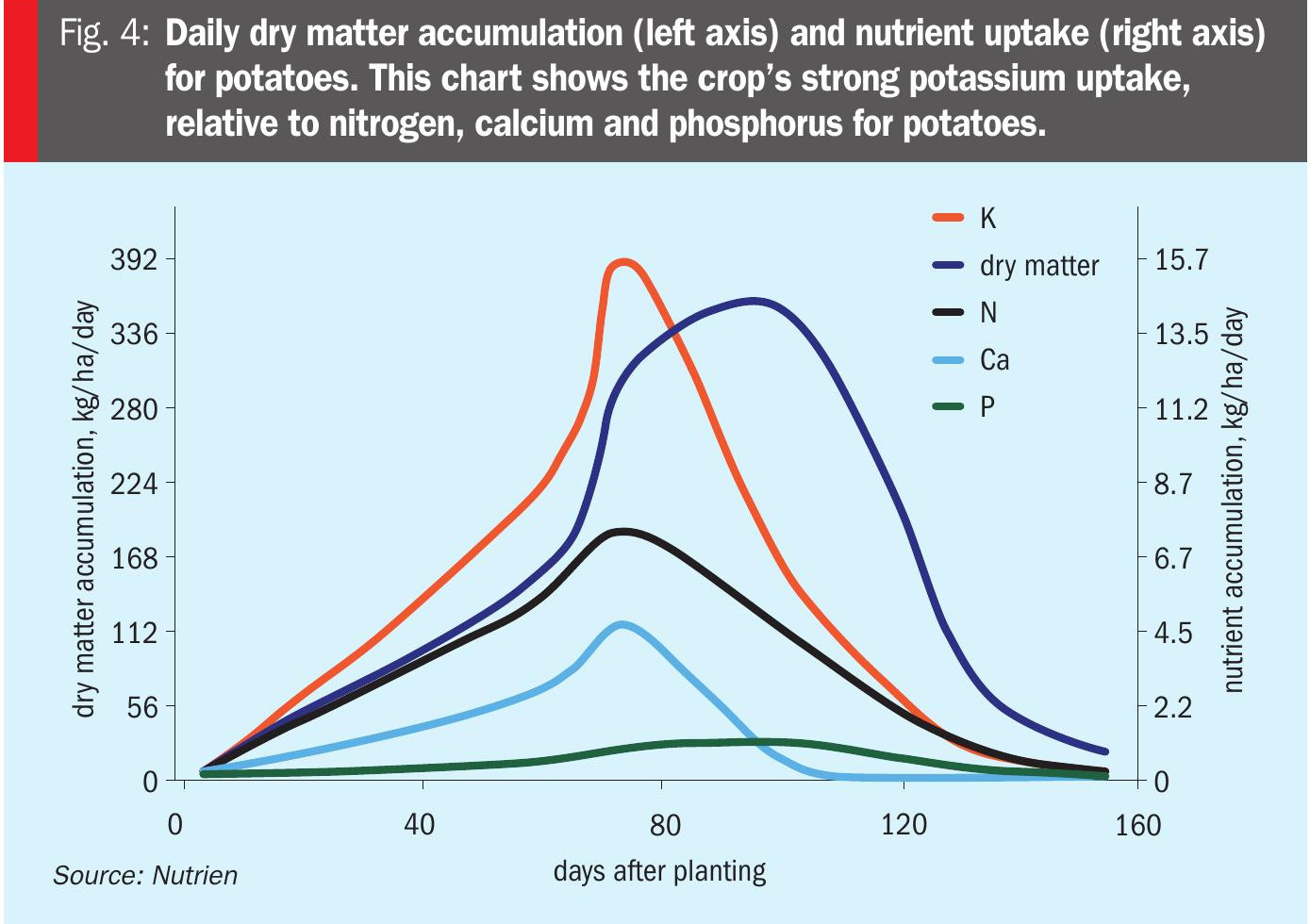
Grapes
Similar to potatoes, grapes are common in many diets around the world. Their popularity is due primarily to the versatility of the of the harvested fruit and the tolerance of grapevines to a wide variety of growing conditions.
Grapes are harvested and then served fresh as table grapes, processed into juice, dried into raisins, and famously fermented to produce wine. Potassium plays a key role in supporting grape yield and quality with this crop having a relatively high K demand as a result.
Figure 5 shows the accumulation of potassium (elemental K basis) in various plant parts (roots, shoots, trunk, vine, and grape bunches) over the growing season. Note the strong sink for potassium in the bunches starting 50 days after budburst and continuing into harvest (green section, Figure 5). Potassium demand peaks while the grape bunches are actively growing – and it should be no surprise that potassium uptake exceeds that of nitrogen and phosphate during this period (Figure 6).
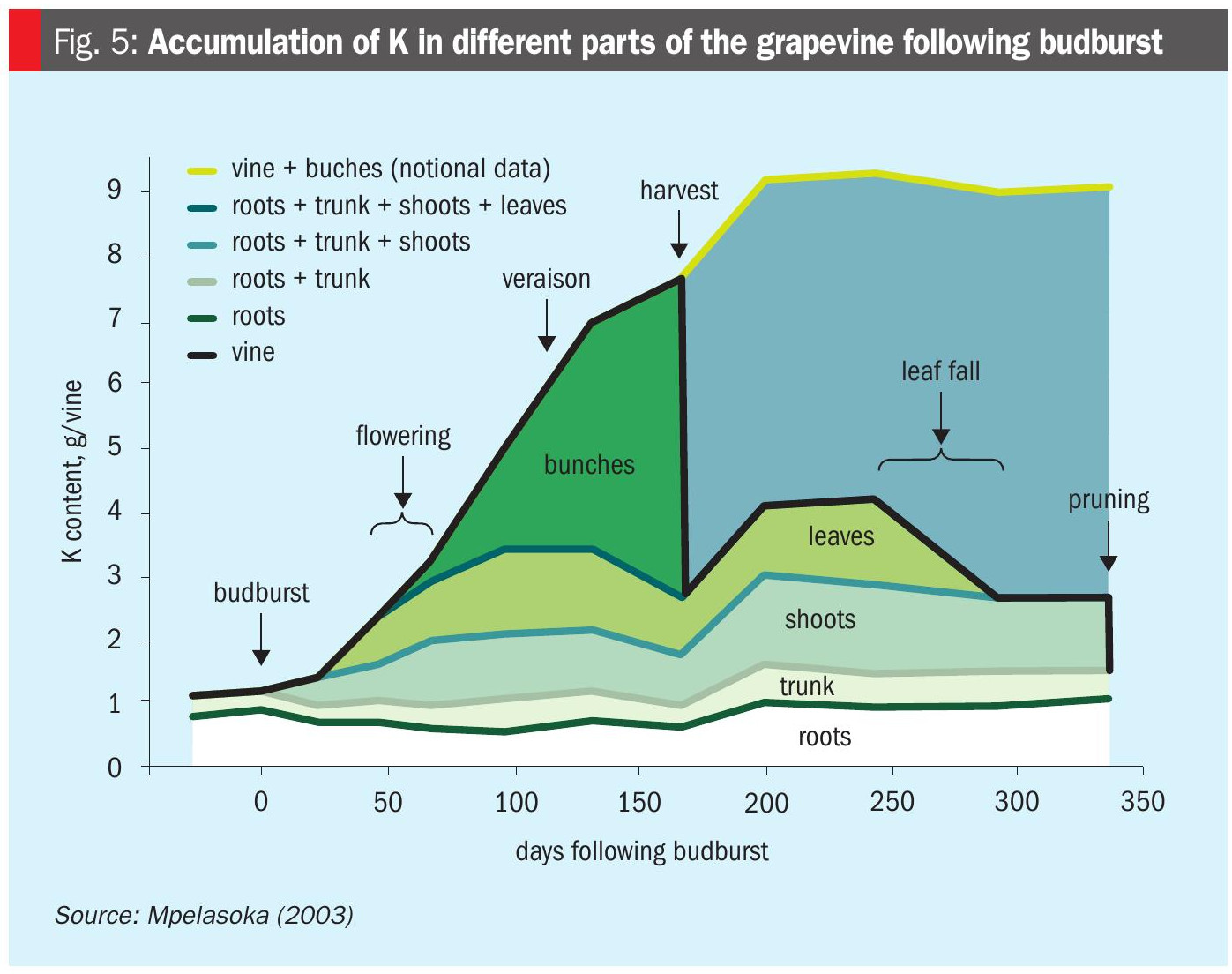
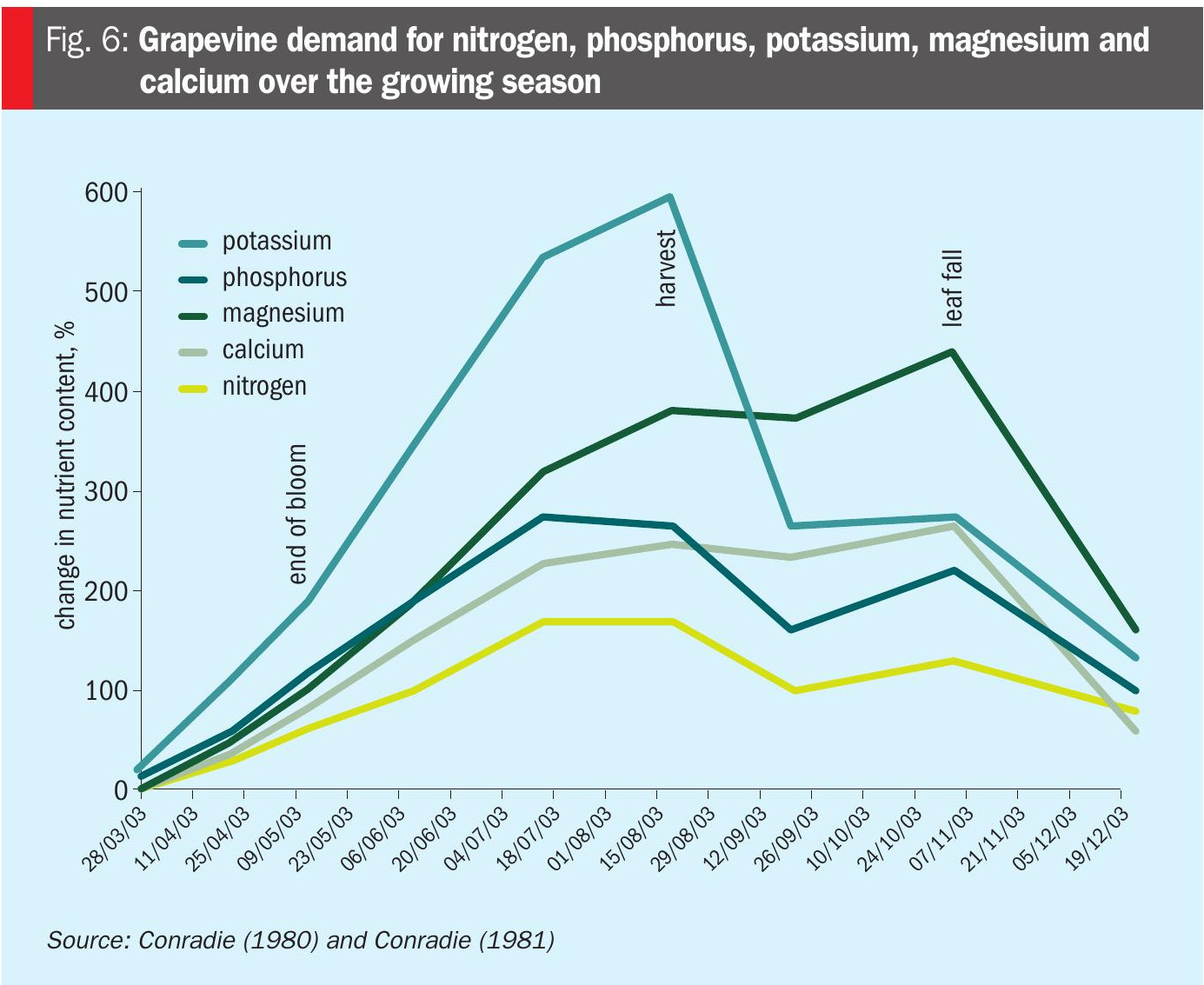
Crop management considerations
Potassium nutrition in specialty crops requires careful management to balance fertilizer input costs, crop performance, and grower profitability. Potassium deficiencies can be addressed using soil tests and the adjustment of nutrient application rates in response.
In-season demand for K can be met through the top dressing of dry granular fertilizers – such as potassium chloride (MOP) or potassium sulphate (SOP) – or via the fertigation or foliar application of water-soluble/liquid potassium fertilizers.
Tissue and soil sampling can help estimate crop nutrient demand through the growing season and are therefore key for informing local nutrient management plans. Moreover, knowing the timings of high K uptake demand (see Figures 3-6) are crucial for understanding when potassium applications should be prioritised.
In general, a strong agronomic understanding of K needs is critical for managing the impact of potassium fertilizer inputs on specialty crops, which often have a higher elevated uptake rate when compared to nitrogen and phosphate. Recognising that plant-available potassium is quite scarce in arable soils helps to focus nutrient management priorities (Figure 7).
Overall, an improved understanding of K nutrition in specialty crops can result in a refined nutrient management plan that optimises crop yield and quality and helps prevent environmental issues.
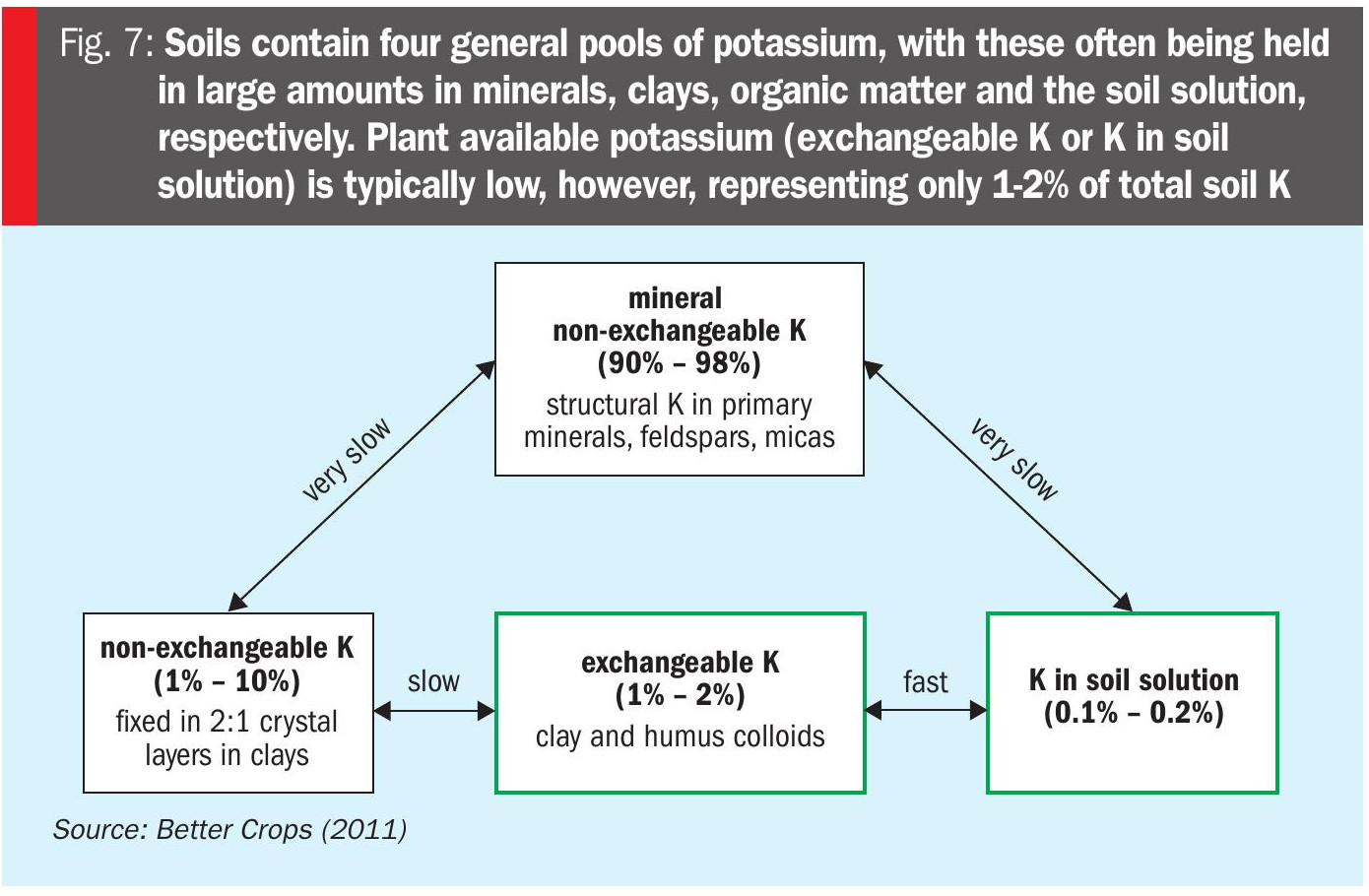
Conclusions
Specialty and horticultural crops are important components of the global agricultural system. These crops are crucial for regional and local food security as harvested products can often be eaten fresh or processed further into familiar food products and beverages (see above sections on potatoes and grapes).
Despite the importance of specialty crops in our daily life, this diverse set of plants are relatively understudied when compared to the ‘Big 4’ row crops – maize, soya, wheat, and rice – that are planted to much higher total hectares each season.
In contrast, studies of the potassium nutrition of specialty crops are relatively rare, although this is understandable given the smaller planted expanse, the niche climate zones needed to grow these crops, and their smaller economic impact globally. Nonetheless, to address existing knowledge gaps, efforts should be made by local university and agricultural professionals to prioritise potassium studies. This is especially vital given the important influence of this nutrient on the yield and quality of specialty crops – and the primacy of potassium uptake by these crop types compared to nitrogen and phosphorus, which still get the lion’s share of research attention currently.
References


